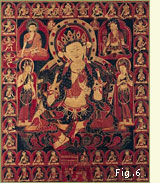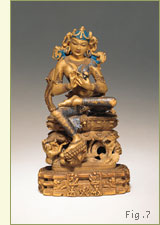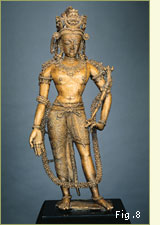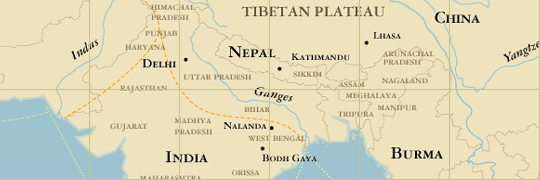 
  
Tibet
Although Buddhism had been introduced to Tibet by the seventh century, the greatest influx of teachers, texts, and images began in the tenth century. This wave came from India's northeastern regions, then ruled by the Pala dynasty, where Mahayana and Vajrayana Buddhism were practiced; it was these two types of Buddhism that were adopted in Tibet. The strong links between Pala-period India and Tibet are demonstrated by an important illustrated Buddhist manuscript (Fig. 5) that has inscriptions in Sanskrit and Tibetan, which trace the manuscript's history from its creation at the famous Nalanda monastery in eastern India, circa 1073, through its use by a number of famous Tibetans over the next 300 years. It was through illustrated manuscripts such as this that both Buddhism and Buddhist art were transmitted from India to Tibet. This stream of Indian influence lasted through the late twelfth and the thirteenth centuries, when Buddhism was annihilated in India, primarily due to Muslim invasions, and many Buddhist monks fled to neighboring countries such as Nepal and Tibet. It was through illustrated manuscripts such as this that both Buddhism and Buddhist art were transmitted from India to Tibet. This stream of Indian influence lasted through the late twelfth and the thirteenth centuries, when Buddhism was annihilated in India, primarily due to Muslim invasions, and many Buddhist monks fled to neighboring countries such as Nepal and Tibet.
 By the fourteenth century, Tibetan artists had synthesized a unique style from Indian, Nepalese, Chinese, and indigenous sources (Fig. 6); however, eleventh- and twelfth-century Tibetan artists often tried to replicate Indian prototypes exactly, which sometimes makes it difficult, even for experts, to distinguish between Pala Indian and early Tibetan art (Fig. 7). However, Tibet also turned west to Kashmir, a prestigious center of Buddhist learning By the fourteenth century, Tibetan artists had synthesized a unique style from Indian, Nepalese, Chinese, and indigenous sources (Fig. 6); however, eleventh- and twelfth-century Tibetan artists often tried to replicate Indian prototypes exactly, which sometimes makes it difficult, even for experts, to distinguish between Pala Indian and early Tibetan art (Fig. 7). However, Tibet also turned west to Kashmir, a prestigious center of Buddhist learning  that produced a number of important scholars and translators over the centuries. It was to Kashmir, for example, that a seventh-century Tibetan king sent envoys in search of a script that would serve the Tibetan language. In 988, a king of western Tibet, Yeshe O, gave royal support for the creation of local workshops to produce images for temples, workshops that likely employed artists from Kashmir. By the tenth and eleventh centuries, Western Tibetan and Kashmiri interactions were so pronounced that until recently a Western Tibetan image of a bodhisattva (Fig. 8) was thought to have been made in Kashmir. that produced a number of important scholars and translators over the centuries. It was to Kashmir, for example, that a seventh-century Tibetan king sent envoys in search of a script that would serve the Tibetan language. In 988, a king of western Tibet, Yeshe O, gave royal support for the creation of local workshops to produce images for temples, workshops that likely employed artists from Kashmir. By the tenth and eleventh centuries, Western Tibetan and Kashmiri interactions were so pronounced that until recently a Western Tibetan image of a bodhisattva (Fig. 8) was thought to have been made in Kashmir.
Back | Next
|
